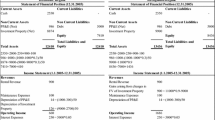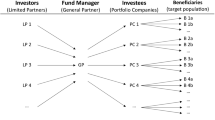Abstract
Based on an abductive analytic study, we examine financial and social value incorporation in the multi-valued market of impact investing. This paper draws on interviews with investment professionals in 54 charitable foundations, intermediary and field building organizations in the impact investing market, to compare market objectives with practice, and to determine whether social and financial values are incorporated, thus producing ‘returns’ of both types through market exchange. We find unincorporated valuation is apparent at both the market level and for several types of investors in contrast with the incorporated or even integrated valuations of other investors. This demonstrates that rather than incorporating logics in a binary or hybrid way, valuation in the moral market of impact investing occurs in a multiplicity of ways and on different levels of the market, depending on a variety of factors including adherence to traditional financial market standards and market design and maintenance.
Similar content being viewed by others
References
André, K., & Pache, A. C. (2016). From caring entrepreneur to caring enterprise: Addressing the ethical challenges of scaling up social enterprises. Journal of Business Ethics, 133(4), 659–675.
Antal, A. B., Hutter, M., & Stark, D. (Eds.). (2015). Moments of valuation: Exploring sites of dissonance. Oxford University Press.
Barman, E. (2016). Caring capitalism: The meaning and measure of social value in the market. Cambridge University Press.
Battilana, J., & Dorado, S. (2010). Building sustainable hybrid organizations: The case of commercial microfinance organizations. Academy of Management Journal, 53(6), 1419–1440.
Bronn, P. S., & Vidaver-Cohen, D. (2009). Corporate motives for social initiative. Legitimacy, sustainability, or the bottom line? Journal of Business Ethics, 87(1), 91–109.
Cahill, G. (2010). Primer on social innovation: A compendium of definitions developed by organizations around the world. The Philanthropist, 23(3), 259–272.
Çalışkan, K., & Callon, M. (2009). Economization, part 1: Shifting attention from the economy toward processes of economization. Economy and Society., 38(3), 369–398.
Çalışkan, K., & Callon, M. (2010). Economization, part 2: A research programme for the study of markets. Economy and Society., 39(1), 1–32.
Chiapello, E., & Godefroy, G. (2017). The dual function of judgment devices: Why does the plurality of market classifications matter? Historical Social Research., 42(1), 152–188.
Cho, C. H. (2009). Legitimation strategies used in response to environmental disasters. A French case study of Total SA’s Erika and AZF Incidents. European Accounting Review, 18(1), 33–62.
Cooper, C., Graham, C., & Himick, D. (2016). Social impact bonds: The securitization of the homeless. Accounting, Organizations and Society, 55, 63–82.
Crane, A., Henriques, I., Husted, B. W., & Matten, D. (2016). What constitutes a theoretical contribution in the business and society field? Business and Society, 55(6), 783–791.
deColle, S., Henriques, A., & Saravasthy, S. (2014). The paradox of corporate social responsibility standards. Journal of Business Ethics., 125(2), 177–191.
Dewey, J. (1939). Theory of valuation. University of Chicago Press.
Ebrahim, A., & Rangan, V. (2014). What impact? A Framework for measuring the scale and scope of social performance. CaliforniaManagement Review, 56(3), 118–141.
Emerson, J. (2003a). Where money meets mission. Stanford Social Innovation Review. Stanford, CA.
Emerson, J. (2003b). The blended value proposition: Integrating social and financial returns. California Management Review, 45(4), 35–51.
Emerson, J. (2018). The purpose of capital: Elements of impact, financial flows and natural being. Blended Value Group Press.
Emirbayer, M. (1997). Manifesto for a relational sociology. American Journal of Sociology., 103(2), 281–317.
Fourcade, M. (2011). Cents and sensibility: Economic valuation and the nature of “nature.” American Journal of Sociology., 116(6), 1721–1777.
Fourcade, M., & Healy, K. (2007). Moral views of market society. Annual Review of Sociology, 33(4), 1–27.
Fourcade, M., & Healy, K. (2017). Seeing like a market. Socio-Economic Review, 15(1), 9–29.
Freireich, J., & Fulton, K. (2009). Investing for social and environmental impact: A design for catalyzing an emerging industry. Monitor Institute.
Glänzel, G., & Scheuerle, T. (2016). Social impact investing in Germany: Current impediments from investors’ and social entrepreneurs’ perspectives. VOLUNTAS International Journal of Voluntary and Nonprofit Organizations, 27(4), 1638–1668.
Global Impact Investing Network. (2021). How big is the impact investing market? Global Impact Investing Network, New York, NY. https://thegiin.org/impact-investing/need-to-know/#how-big-is-the-impact-investing-market
Harji, K., & Jackson, E. T. (2012). Accelerating impact: Achievements, challenges and what's next in building the impact investing industry. The Rockefeller Foundation, New York, NY.
Hehenberger, L., & Harling, A. (2018). Moving towards “impact-adjusted” financial returns. American Journal of Evaluation, 39(3), 408–412.
Hehenberger, L., Mair, J., & Metz, A. (2019). The assembly of a field ideology: An idea centric perspective on systemic power in impact investing. Academy of Management Journal., 62(6), 1672–1704.
Hirschman, A. (1982). Rival interpretations of market society: Civilizing, destructive, or feeble? Journal of Economic Literature, 20(4), 1463–1484.
Höchstädter, A. K., & Scheck, B. (2015). What’s in a name: An analysis of impact investing understandings by academics and practitioners. Journal of Business Ethics, 132(2), 449–475.
Jaber, T., & Oftedal, E. M. (2020a). Legitimacy for sustainability: A case of a strategy change for an oil and gas company. Sustainability., 12(2), 525.
Jaber, T., & Oftedal, E. M. (2020b). Legitimacy for sustainability: A case of a strategy change for an oil and gas company. Sustainability, 12(2), 525.
Kroeger, A., & Weber, C. (2014). Developing a conceptual framework for comparing social value creation. Academy of Management Review., 34(4), 513–540.
Lamont, M. (2012). Toward a comparative sociology of valuation and evaluation. Annual Review of Sociology, 38, 1–21.
Lehner, O. M., & Nicholls, A. (2014). Social finance and crowdfunding for social enterprises: A public–private case study providing legitimacy and leverage. Venture Capital, 16(3), 271–286.
Lorino, P. (2018). Pragmatism and organization studies. Oxford University Press.
Mair, J., & Hehenberger, L. (2014). Frontstage and backstage convening: The transition from opposition to mutualistic coexistence in organizational philanthropy. Academy of Management Journal, 57(4), 1174–1200.
Mason, C., & Doherty, B. (2016). A fair trade-off? Paradoxes in the governance of fair-trade social enterprises. Journal of Business Ethics, 136(3), 451–469.
McHugh, N., Sinclair, S., Roy, M., Huckfield, L., & Donaldson, C. (2013). Social impact bonds: A wolf in sheep’s clothing? Journal of Poverty and Social Justice, 21(3), 247–257.
Milanés-Montero, P., & Pérez-Calderón, E. (2011). Corporate environmental disclosure and legitimacy theory: A european perspective. Environmental Engineering and Management Journal., 10(12), 1883–1891.
Millar, R., & Hall, K. (2013). Social return on investment (SROI) and performance measurement: The opportunities and barriers for social enterprises in health and social care. Public Management Review, 15(6), 923–941.
Muniesa, F. (2012). A flank movement in the understanding of valuation. In L. Adkins & C. Lury (Eds.), Measure and value (pp. 24–38). Wiley-Blackwell.
National Conference of Commissioners on Uniform State Laws. (2006). Uniform Prudent Management of Institutional Funds Act, Annual Conference Meeting, July 7–14. https://www.uniformlaws.org/viewdocument/final-act-no-comments-58?CommunityKey=043b9067-bc2c-46b7-8436-07c9054064a3&tab=librarydocuments
Nicholls, A. (2010). The institutionalization of social investment: The interplay of investment logics and investor rationalities. Journal of Social Entrepreneurship, 1(1), 70–100.
Nicholls, A. (2018). A general theory of social impact accounting: Materiality, uncertainty and empowerment. Journal of Social Entrepreneurship., 9(2), 132–153.
Nicholls, A., Nicholls, J., & Paton, R. (2015). Measuring social impact. In A. Nicholls, R. Paton, & J. Emerson (Eds.), Social finance (pp. 253–281). Oxford University Press.
Ormiston, J., Charlton, K., Donald, M. S., & Seymour, R. G. (2015). Overcoming the challenges of impact investing: Insights from leading investors. Journal of Social Entrepreneurship, 6(3), 352–378.
Pache, A., & Santos, F. (2010). When worlds collide: The internal dynamics of organizational responses to conflicting institutional demands. Academy of Management Review., 35, 455–476.
Pache, A., & Santos, F. (2013). Embedded in hybrid contexts: How individuals in organizations respond to competing institutional logics. Research in the Sociology of Organizations, 39, 3–35.
Painter, M., Hibbert, S., & Cooper, T. (2019). The development of responsible and sustainable business practice: Value, mindsets, business-models. Journal of Business Ethics., 157(4), 885–891.
Palazzo, G., & Scherer, A. G. (2006). Corporate legitimacy as deliberation: A communicative framework. Journal of Business Ethics., 66(1), 71–88.
Qu, H., & Osili, U. (2017). Beyond grantmaking: An investigation of program-related investments by U.S. foundations. Nonprofit and Voluntary Sector Quarterly, 46(2), 305–329.
Richards, M., Zellweger, T., & Gond, J. P. (2017). Maintaining moral legitimacy through worlds and words: An explanation of firms’ investment in sustainability certification. Journal of Management Studies., 54(5), 676–710.
Rotman, L. (2017). Understanding fiduciary duties and relationship fiduciarity. McGill Law Journal, 62(4), 974–1041.
Santos, F., Pache, A. C., & Birkholz, C. (2015). Making hybrids work: Aligning business models and organizational design for social enterprises. California Management Review, 57(3), 36–58.
Sardy, M., & Lewin, R. (2016). Towards a global framework for impact investing. Academy of Economics and Finance Journal, 7, 73–79.
Schaltegger, S., & Hörisch, J. (2017). In search of the dominant rationale in sustainability management: Legitimacy- or profit-seeking? Journal of Business Ethics, 145(2), 259–276.
Schramade, W. 2019. Place-based impact investing: The case of social impact fund rotterdam. Available at SSRN: https://ssrn.com/abstract=3489993 or https://doi.org/10.2139/ssrn.3489993
Stark, D. (2009). The sense of dissonance: Accounts of worth in economic life. Princeton University Press.
Strauss, A., & Corbin, J. (1998). Basics of qualitative research: Techniques and procedures for developing grounded theory. Sage Publications Inc.
Suchman, M. (1995). Managing legitimacy: Strategic and institutional approaches. Academy of Management Review, 20(3), 571–610.
Surie, G., & Ashley, A. (2008). Integrating pragmatism and ethics in entrepreneurial leadership for sustainable value creation. Journal of Business Ethics, 81(1), 235–246.
Tavory, I., & Timmermans, T. (2014). Abductive analysis: Theorizing qualitative research. The University of Chicago Press.
Tekula, R., & Andersen, K. (2018). The role of government, nonprofit and private facilitation in the impact investing marketplace. Public Performance and Management Review., 42(1), 142–161.
Thornley, B., & Dailey, C. (2010). Building scale in community impact investing through nonfinancial performance measurement. Community Development Investment Review, 6(1), 1–46.
Urban Institute. (2020). The Nonprofit Sector in Brief. Urban Institute. Washington, D.C. https://nccs.urban.org/publication/nonprofit-sector-brief-2019
Visser, M. (2019). Pragmatism, critical theory and business ethics. Journal of Business Ethics, 156(1), 45–57.
Wood, D., Thornley, B., & Grace, K. (2013). Institutional impact investing: Practice and policy. Journal of Sustainable Finance & Investment, 3(2), 75–94.
Acknowledgements
The authors are grateful to Professor Saurabh Lall for their suggestions and feedback on this paper.
Author information
Authors and Affiliations
Corresponding author
Ethics declarations
Conflict of interest
The authors declare no conflict of interest.
Ethical Approval
This paper is written in compliance with the Journal of Business Ethics’ Ethical Standards.
Additional information
Publisher's Note
Springer Nature remains neutral with regard to jurisdictional claims in published maps and institutional affiliations.
Rights and permissions
About this article
Cite this article
Andersen, K., Tekula, R. Value, Values, and Valuation: The Marketization of Charitable Foundation Impact Investing. J Bus Ethics 179, 1033–1052 (2022). https://doi.org/10.1007/s10551-022-05159-1
Received:
Accepted:
Published:
Issue Date:
DOI: https://doi.org/10.1007/s10551-022-05159-1




